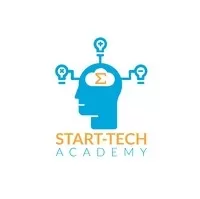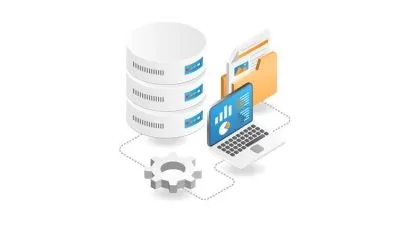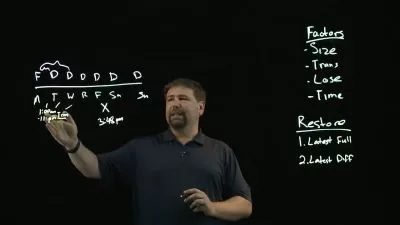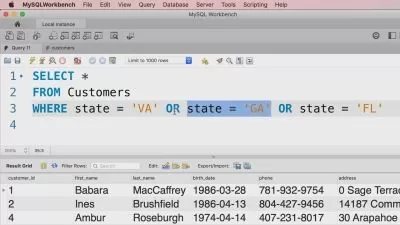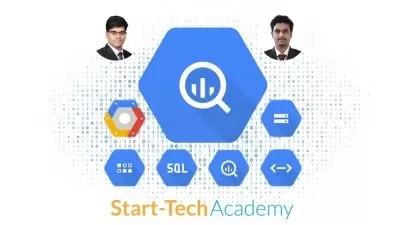PostgreSQL and MySQL for Beginners
Start-Tech Academy,Start-Tech Trainings
8:59:24
Description
Learn most popular SQL dialects, PostgreSQL & MySQL. Learn SQL concepts, practice & compare syntax of PostgreSQL & MySQL
What You'll Learn?
- How to write SELECT queries to fetch relevant data in PostgreSQL and MySQL
- How to filter and sort the data using WHEN, logical operators and ORDER BY
- How to group and aggregate data in PostgreSQL and MySQL
- How to apply joins and combining queries in PostgreSQL and MySQL
- String, mathematical, date-time functions and pattern matching in PostgreSQL and MySQL
- Understanding of VIEWS and INDEXES in PostgreSQL and MySQL
- How to write subqueries in PostgreSQL and MySQL
Who is this for?
More details
Description4 Reasons why you should choose this SQL course
Carefully designed curriculum teaching you everything in SQL that you will need for Data analysis in businesses
Comprehensive - covers basic and advanced SQL statements in both, PostgreSQL and MySQL
Downloadable resources covering important topics on SQL
Your queries on SQL and anything covered in the Masterclass will be responded by the Instructor himself
A Verifiable Certificate of Completion is presented to all students who undertake this SQL course.
Why should you choose this course?
This is a complete tutorial on SQL which can be completed within a weekend. SQL is the most sought after skill for Data analysis roles in all the companies. PostgreSQL and MySQL are highly desired skills for database management and data analysis roles. So whether you want to start a career as a data scientist or just grow you data analysis skills, this course will cover everything you need to know to do that.
What makes us qualified to teach you?
The course is taught by Abhishek, Pukhraj and Nadeem. Instructors of the course have been teaching Data Science and Machine Learning for over a decade. They have an in-depth knowledge in advanced SQL, PostgreSQL, MySQL, database management, and various data analysis tools available in the market.
We are also the creators of some of the most popular online courses - with over 1 million enrollments and thousands of 5-star reviews like these ones:
I had an awesome moment taking this course. It broaden my knowledge more on the power use of SQL as an analytical tools. Kudos to the instructor! - Sikiru
Very insightful, learning very nifty tricks and enough detail to make it stick in your mind. - Armand
Our Promise
Teaching our students is our job and we are committed to it. If you have any questions about the course content, practice sheet or anything related to any topic, you can always post a question in the course or send us a direct message.
By the end of this course, your confidence in using SQL will soar. You'll have a thorough understanding of how to use SQL for Data analytics as a career opportunity.
Go ahead and click the enroll button, and I'll see you in lesson 1!
Cheers
Start-Tech Academy
FAQ's
Why learn SQL?
SQL is the most universal and commonly used database language. It powers the most commonly used database engines like PostgreSQL, SQL Server, SQLite, and MySQL. Simply put, If you want to access databases then yes, you need to know SQL.
It is not really difficult to learn SQL. SQL is not a programming language, it’s a query language. The primary objective where SQL was created was to give the possibility to common people to get interesting data from the database. It is also an English-like language so anyone who can use English at a basic level can write SQL queries easily.
SQL is one of the most sought-after skills by hiring employers.
You can earn good money
How much time does it take to learn SQL?
SQL is easy but no one can determine the learning time it takes. It totally depends on you. The method we adopted to help you learn SQL quickly starts from the basics and takes you to advanced level within hours. You can follow the same, but remember you can learn nothing without practicing it. Practice is the only way to learn SQL quickly.
What's the difference between SQL and PostgreSQL?
SQL is a language. Specifically, the "Structured Query Language"
PostgreSQL is one of several database systems, or RDMS (Relational Database Management System). PostgresSQL is one of several RDMS's, others of which are Oracle, Informix, MySQL, and MSQL.
All of these RDMSs use SQL as their language. Each of them have minor variations in the "dialect" of SQL that they use, but it's all still SQL.
Which is better, PostgreSQL or MySQL?
Both are excellent products with unique strengths, and the choice is often a matter of personal preference.
PostgreSQL offers overall features for traditional database applications, while MySQL focuses on faster performance for Web-based applications.
Open source development will bring more features to subsequent releases of both databases.
Who uses these databases?
Here are a few examples of companies that use PostgreSQL: Apple, BioPharm, Etsy, IMDB, Macworld, Debian, Fujitsu, Red Hat, Sun Microsystem, Cisco, Skype.
Companies that use MySQL: Uber, Airbnb, Netflix, Udemy, Pinterest etc.
Who this course is for:
- Working Professionals beginning their Data journey
- Anyone curious to learn and compare both PostgreSQL and MySQL
- Students about to join their first corporate job
4 Reasons why you should choose this SQL course
Carefully designed curriculum teaching you everything in SQL that you will need for Data analysis in businesses
Comprehensive - covers basic and advanced SQL statements in both, PostgreSQL and MySQL
Downloadable resources covering important topics on SQL
Your queries on SQL and anything covered in the Masterclass will be responded by the Instructor himself
A Verifiable Certificate of Completion is presented to all students who undertake this SQL course.
Why should you choose this course?
This is a complete tutorial on SQL which can be completed within a weekend. SQL is the most sought after skill for Data analysis roles in all the companies. PostgreSQL and MySQL are highly desired skills for database management and data analysis roles. So whether you want to start a career as a data scientist or just grow you data analysis skills, this course will cover everything you need to know to do that.
What makes us qualified to teach you?
The course is taught by Abhishek, Pukhraj and Nadeem. Instructors of the course have been teaching Data Science and Machine Learning for over a decade. They have an in-depth knowledge in advanced SQL, PostgreSQL, MySQL, database management, and various data analysis tools available in the market.
We are also the creators of some of the most popular online courses - with over 1 million enrollments and thousands of 5-star reviews like these ones:
I had an awesome moment taking this course. It broaden my knowledge more on the power use of SQL as an analytical tools. Kudos to the instructor! - Sikiru
Very insightful, learning very nifty tricks and enough detail to make it stick in your mind. - Armand
Our Promise
Teaching our students is our job and we are committed to it. If you have any questions about the course content, practice sheet or anything related to any topic, you can always post a question in the course or send us a direct message.
By the end of this course, your confidence in using SQL will soar. You'll have a thorough understanding of how to use SQL for Data analytics as a career opportunity.
Go ahead and click the enroll button, and I'll see you in lesson 1!
Cheers
Start-Tech Academy
FAQ's
Why learn SQL?
SQL is the most universal and commonly used database language. It powers the most commonly used database engines like PostgreSQL, SQL Server, SQLite, and MySQL. Simply put, If you want to access databases then yes, you need to know SQL.
It is not really difficult to learn SQL. SQL is not a programming language, it’s a query language. The primary objective where SQL was created was to give the possibility to common people to get interesting data from the database. It is also an English-like language so anyone who can use English at a basic level can write SQL queries easily.
SQL is one of the most sought-after skills by hiring employers.
You can earn good money
How much time does it take to learn SQL?
SQL is easy but no one can determine the learning time it takes. It totally depends on you. The method we adopted to help you learn SQL quickly starts from the basics and takes you to advanced level within hours. You can follow the same, but remember you can learn nothing without practicing it. Practice is the only way to learn SQL quickly.
What's the difference between SQL and PostgreSQL?
SQL is a language. Specifically, the "Structured Query Language"
PostgreSQL is one of several database systems, or RDMS (Relational Database Management System). PostgresSQL is one of several RDMS's, others of which are Oracle, Informix, MySQL, and MSQL.
All of these RDMSs use SQL as their language. Each of them have minor variations in the "dialect" of SQL that they use, but it's all still SQL.
Which is better, PostgreSQL or MySQL?
Both are excellent products with unique strengths, and the choice is often a matter of personal preference.
PostgreSQL offers overall features for traditional database applications, while MySQL focuses on faster performance for Web-based applications.
Open source development will bring more features to subsequent releases of both databases.
Who uses these databases?
Here are a few examples of companies that use PostgreSQL: Apple, BioPharm, Etsy, IMDB, Macworld, Debian, Fujitsu, Red Hat, Sun Microsystem, Cisco, Skype.
Companies that use MySQL: Uber, Airbnb, Netflix, Udemy, Pinterest etc.
Who this course is for:
- Working Professionals beginning their Data journey
- Anyone curious to learn and compare both PostgreSQL and MySQL
- Students about to join their first corporate job
User Reviews
Rating
Start-Tech Academy
Instructor's CoursesStart-Tech Trainings
Instructor's Courses
Udemy
View courses Udemy- language english
- Training sessions 104
- duration 8:59:24
- Release Date 2022/12/24





